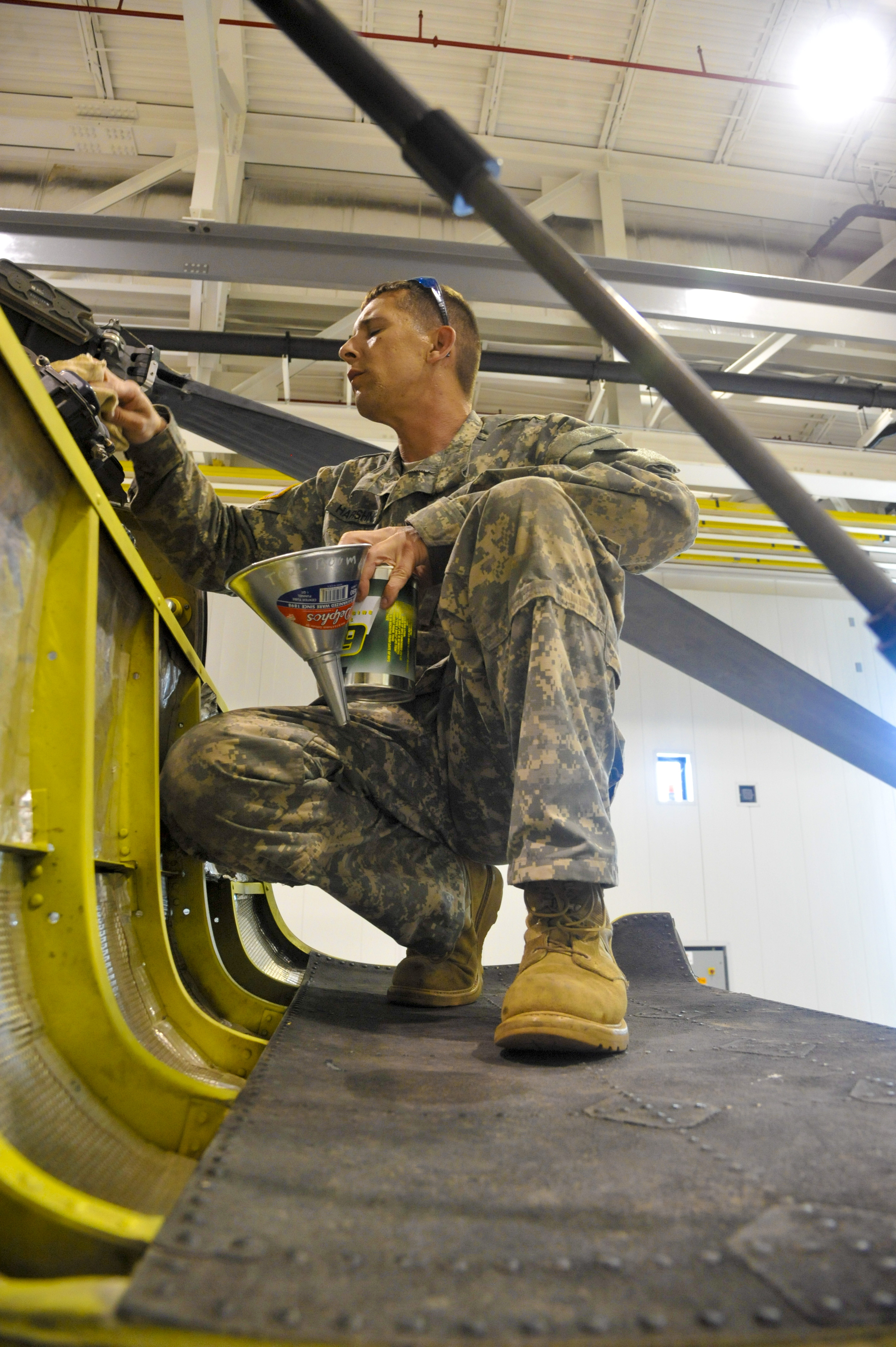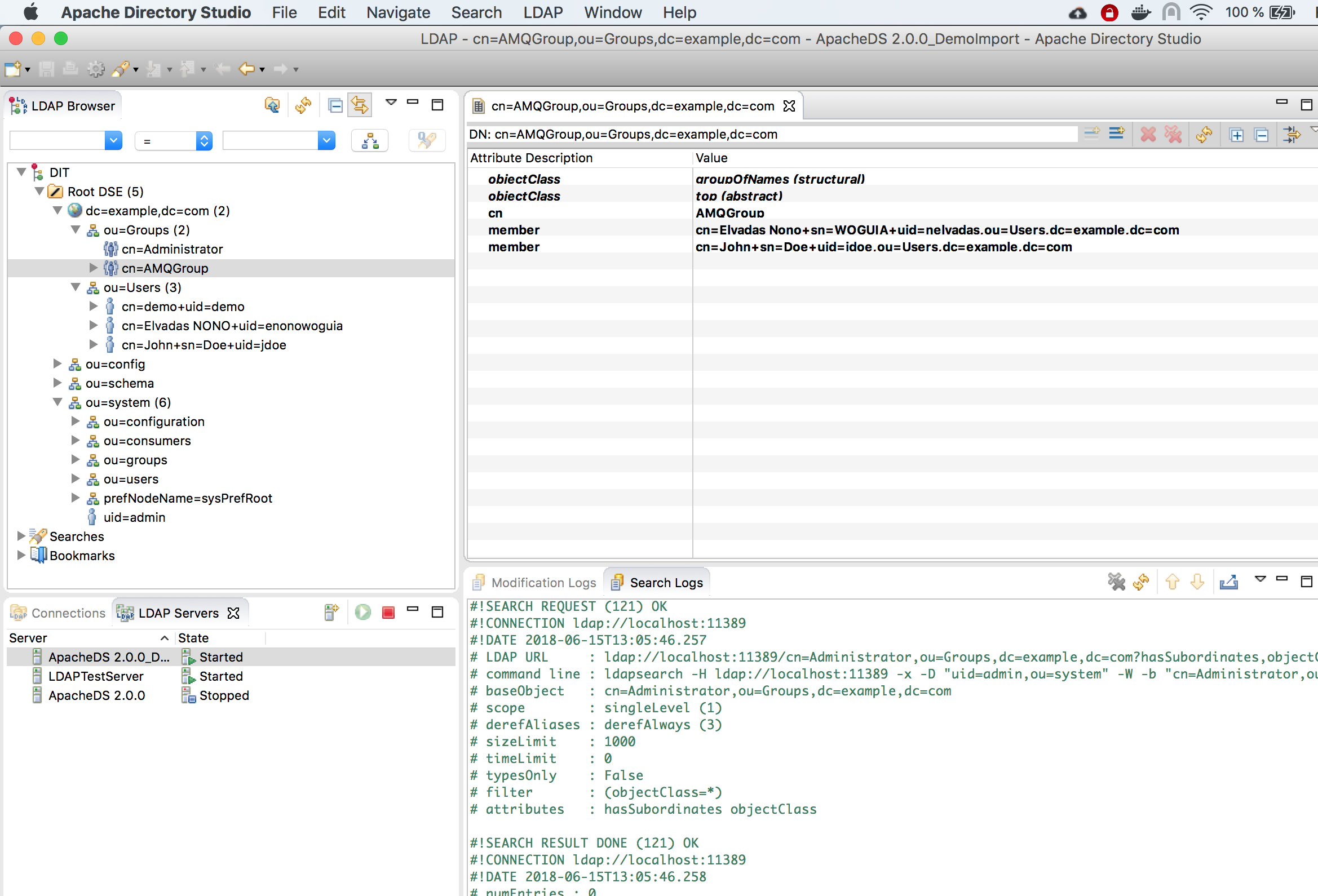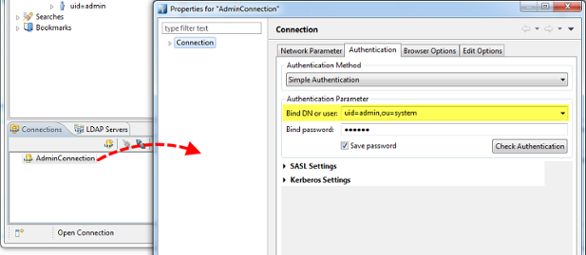In this section, we will describe how to setup an LDAP server using Apache Directory Studio to test the LDAP authentication in Crafter Studio.
First, we’ll configure LDAP authentication in Crafter Studio, then proceed to install and setup the LDAP server using Apache Directory Studio, then finally login to Crafter Studio with the users setup in the LDAP server.
Apache Directory Studio is a Desktop application which basically is used as an LDAP tooling platform for the LDAP server which was intentionally designed for Apache DS. The basic purpose of the application is to handle LDAP databases of the Apache HTTPD server.
Configure LDAP authentication in Crafter Studio¶
- Apache Directory Studio is a complete directory tooling platform intended to be used with any LDAP server however it is particularly designed for use with ApacheDS. It is an Eclipse RCP application, composed of several Eclipse (OSGi) plugins, that can be easily upgraded with additional ones. These plugins can even run within Eclipse itself.
- Mar 10, 2015 Fortunately, the Apache Directory Project has released the Apache Directory Studio (this isn’t new software, I’ve just never written about it) to help deal with LDAP.
We will first configure LDAP authentication in Crafter Studio. In your Authoring installation, go to shared/classes/crafter/studio/extension and add the following lines to studio-config-override.yaml. (The server url, bindDN and password are all default values of the Apache Directory Studio) Stop and restart Crafter Studio after making your changes.
For more information on configuring LDAP authentication in Crafter Studio, please follow the guide here: Configure LDAP Authentication
Please note that the LDAP attributes are configurable and in our example above, we are using o for the attribute for siteId instead of crafterSite and ou for the attribute for groupName instead of crafterGroup as listed in Configure LDAP Authentication

Install Apache Directory Studio¶
Download and install Apache Directory Studio from here: http://directory.apache.org/studio/
Setup the LDAP server¶
We will first create our LDAP server. Launch your Apache Directory Studio application. Notice the tabs on the lower left hand corner. Click on the LDAP Servers tab. To create the server, click on the New Server icon, the first icon to the right of the LDAP Servers tab.
A dialog to create the server will appear, go the the Select the server type: section of the dialog. For our example, select ApacheDS 2.0.0 then click on the Finish button.

Next we’ll start our LDAP server. Click on the LDAP server we just created, ApacheDS 2.0.0, which will be displaying the status Stopped. To start the server, click on the green button right next to the tabs:
We’ll now need to connect the LDAP browser to our newly created LDAP server. To connect to the server, in the LDAP Server tab, right click on the server ApacheDS 2.0.0, then select Create a Connection


Click on the Connections tab, you should now see ApacheDS 2.0.0 listed.
Load some data into the LDAP Server¶
The server we setup earlier does not have any data yet. We will now load some data by using the LDIF editor. LDIF or LDAP Data Interchange Format, is a text format for representing LDAP data and commands. To open an LDIF editor, click on the New icon at the top left, or click File -> New, a dialog will appear with a list, select LDIF File under LDAP Browser
An empty file in the middle of your ApacheDS will appear. This is the LDIF editor. We will now enter some data into it to create users that Crafter Studio can authenticate through the LDAP Server we just setup. We will add three users, each belonging to a different group for the site myawesomesite in Crafter Studio. Please make sure that the attributes listed in the Crafter Studio LDAP configuration is configured in the LDAP server for each user. Copy and paste the data listed below into the LDIF editor. Make sure that there is an empty line after the last entry.
Please note that a user can belong to multiple groups and sites. To add another siteId or groupName value in the ldif file, just add another line specifying the attribute and the value. Notice the multiple values for the attributes ou (groupName) and o (siteId)
To add the data we entered in the LDIF file into the LDAP Server, first, click on the Browse button in the LDIF editor and select the connection we setup (ApacheDS 2.0.0), then click on the green (Execute LDIF) button next to the Browse button to get our data into the server.
After executing the LDIF file, you should see the results in the Modification Logs tab at the bottom of the LDIF Editor and should look something like the image below:
We should also be able to see the three users we just added in the LDAP browser
Changing a user’s password in the LDAP server¶

Notice that we set the password to the same characters for all the users. Let’s change the password for all the users. To do this, from the LDAP Browser tab, navigate to DIT -> Root DSE -> dc=example,dc=com -> ou=Users, then click on the name os a user. We’ll click on user Jane Doe. A new tab will open in the middle of your ApacheDS with all the attributes for user Jane Doe. Double click on userPassword to change the user’s password,
The Password Editor dialog will now be in focus. Click on New Password at the middle top and fill in the Enter New Password and Confirm New Password fields in the form, then click on the OK button
Apache Directory Studio Download
To test the new password you just entered, double click on userPassword attribute of the user, then click on Current Password in the Password Editor dialog. Enter the new password in the Verify Password field, then click on the Verify button.
When successful, a dialog will appear that the password was verified successfully
Repeat the steps listed above for the rest of the users we added in to the LDAP server to change their password. After changing all the user’s passwords, we can now try to login to Crafter Studio using the credentials of the users we just added.
Logging in to Crafter Studio as an LDAP user¶
Apache Directory Studio Linux
In your browser, enter localhost:8080studio. Fill in the the username and password using one of the users we setup in the LDAP server. In the image below, we will log in the user jbloggs. If authentication is successful, the user should be taken to the Sites screen of Crafter Studio.